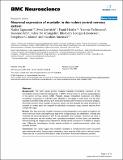Neuronal expression of muskelin in the rodent central nervous system
Author(s)
Tagnaouti, Nadia; Loebrich, Sven; Heisler, Frank F; Pechmann, Yvonne; Fehr, Susanne; De Arcangelis, Adele; Georges-Labouesse, Elisabeth; Adams, Josephine C; Kneussel, Matthias; Loebrich, Sven; ... Show more Show less
Download1471-2202-8-28.pdf (2.250Mb)
PUBLISHER_CC
Publisher with Creative Commons License
Creative Commons Attribution
Terms of use
Metadata
Show full item recordAbstract
Background: The kelch repeat protein muskelin mediates cytoskeletal responses to the extracellular matrix protein thrombospondin 1, (TSP1), that is known to promote synaptogenesis in the central nervous system (CNS). Muskelin displays intracellular localization and affects cytoskeletal organization in adherent cells. Muskelin is expressed in adult brain and has been reported to bind the Cdk5 activator p39, which also facilitates the formation of functional synapses. Since little is known about muskelin in neuronal tissues, we here analysed the tissue distribution of muskelin in rodent brain and analysed its subcellular localization using cultured neurons from multiple life stages. Results: Our data show that muskelin transcripts and polypeptides are expressed throughout the central nervous system with significantly high levels in hippocampus and cerebellum, a finding that resembles the tissue distribution of p39. At the subcellular level, muskelin is found in the soma, in neurite projections and the nucleus with a punctate distribution in both axons and dendrites. Immunostaining and synaptosome preparations identify partial localization of muskelin at synaptic sites. Differential centrifugation further reveals muskelin in membrane-enriched, rather than cytosolic fractions. Conclusion: Our results suggest that muskelin represents a multifunctional protein associated with membranes and/or large protein complexes in most neurons of the central nervous system. These data are in conclusion with distinct roles of muskelin's functional interaction partners.
Date issued
2007-05Department
Picower Institute for Learning and MemoryJournal
BMC Neuroscience
Publisher
BioMed Central Ltd
Citation
BMC Neuroscience. 2007 May 02;8(1):28
Version: Final published version
ISSN
1471-2202